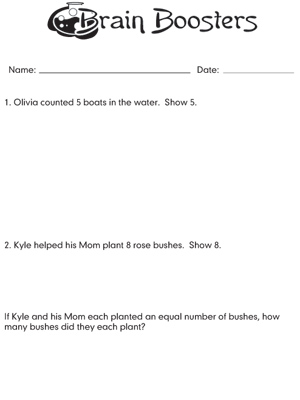Essential Question: How do we figure out how many items are in each group (when we know the total and number of groups)?
Give students a problem like the one below:
Mike has 8 cookies. He wants to share the cookies with 2 people. How many cookies does each person get?
I have seen student problems such as the following:
- Some students will look at the 8 and the 2 and just add or subtract them. They are not using the context of the story. (Sometimes this is because they are rushing and not thinking and sometimes they do not understand what the problem is asking them to do. See below)
- Some will add 8 + 8. With these students, the following discussion is crucial.
I like to draw a + sign and a – sign and ask the students if we are adding any more to the 8 cookies. Is someone giving us more cookies? Are we buying more cookies? Most of the time, the students can answer no easily. I mark out the addition sign.
Then I ask if we are subtracting any cookies. Did we eat any (yet)? No, so cross out the subtraction sign.
So, what are we doing?
Talk to the students about sharing equally (this goes by many names-fair shares, equal grouping …). We are not adding any more or losing any-we are just splitting up what we have. By the end of second grade I draw a division sign and start a discussion about sharing being the same thing as splitting things into groups or dividing.
What do we know?
We know we have 8 cookies (total).
We know we need to split them into 2 groups (# of groups).
What are we trying to figure out?
How many cookies will be in each group? How many will each person get?
Give the students 8 “cookies”. You can use construction paper cookies, real cookies, counters, cubes, anything! Let the students explore and struggle with the problem.
This is where many teachers/parents go wrong. They show the kids what to do first. It is important to talk about the problem first. But after you have made sure the kids understand what they are trying to solve, let them go.
After the students have solved the problem or struggled for a while, let them discuss what they tried.
If your student is stuck, try putting two pieces of plain paper out. These represent the 2 groups they are trying to make. This helps some students visualize the two groups by alternating putting counters on them.
There are different types of equal grouping problems.
Work with problems like the ones above at first. They tell the total number of items and number of groups. Students begin fair shares with the passing-out strategy. If they know how many groups they are sharing between it makes it easier for them to start passing out cubes or tally marks to solve the problem.
Then give students problems where they know the total number of items but instead of knowing how many groups, they just know how many items are in the group. They have to figure out how many groups. Here’s an example:
It cost $2 to ride each ride at the fair. Jason spent $22. How many rides did he ride?
In this problem students have to figure out how many groups of 2 are in 22. This is usually much harder for kids.
Once again, give your student manipulatives and let them go to work. If they are still struggling after some time, ask them to count by 2s and record their count.
2, 4, 6, 8, 10 12, 14, 16, 18, 20, 22
Some will think 22 is the answer because it is the last number recorded. Point back to the problem and remind them that we already knew that Jason spent $22. We are trying to figure out how many rides he rode. How many $2 rides could he have ridden for $22? You can suggest that they count how many groups of 2 they have.
Include equal grouping problems with leftovers or remainders.
Susan has 7 books. She wants to share them equally with 2 people. How many books does each person get?
Are there any leftovers? If so, how many?
Then, begin to work with students on splitting the leftovers into fractional parts.
Mrs. Thach has 7 candy bars to split with 3 kids. She does not want any leftovers so break the leftover candy bar into fractional parts and share. How much does each kid get?
Students will share like traditional problems but may struggle with what to do with the leftover bar. Ask how many groups (or people) there are sharing it? Can you split the candy bar into that many groups?
Equal grouping lends itself to a perfect transition into fractions.




